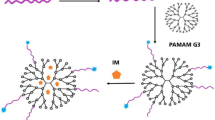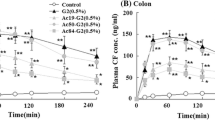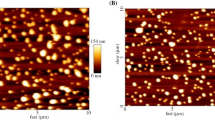Abstract
Purpose
To investigate potential application of poly(amidoamine) (PAMAM) dendrimers for improving the delivery of SN-38.
Methods
Complexes of SN-38 with generation 4 amine terminated PAMAM dendrimers were synthesized with varying amounts of drug. Stability of the complexes as well as influence of complexation on permeability across and cellular uptake by Caco-2 cells was evaluated.
Results
The complexes were stable at pH 7.4 and drug was released at pH 5. A tenfold increase in permeability and more than hundredfold increase in cellular uptake of the complexes with respect to free SN-38 was observed.
Conclusions
Studies suggest that complexation with PAMAM dendrimers has the potential to improve the oral bioavailability of SN-38.






Similar content being viewed by others
References
H. Ulukan, and P. W. Swaan. Camptothecins: a review of their chemotherapeutic potential. Drugs. 62:2039–2057 (2002).
Y. Shimada, M. Rothenberg, S. G. Hilsenbeck, H. A. Burris III, D. Degen, and D. D. Von Hoff. Activity of CPT-11 (irinotecan hydrochloride), a topoisomerase I inhibitor, against human tumor colony-forming units. Anticancer Drugs. 5:202–206 (1994).
P. J. Houghton, P. J. Cheshire, J. C. Hallman, M. C. Bissery, A. Mathieu-Boue, and J. A. Houghton. Therapeutic efficacy of the topoisomerase I inhibitor 7-ethyl-10-(4-[1-piperidino]-1-piperidino)-carbonyloxy-camptothecin against human tumor xenografts: lack of cross-resistance in vivo in tumors with acquired resistance to the topoisomerase I inhibitor 9-dimethylaminomethyl-10-hydroxycamptothecin. Cancer Res. 53:2823–2829 (1993).
P. Calabresi, B. A. Chabner, J. G. Hardman, and L. E. Limbird. Chemotherapy of Neoplastic Diseases, Goodman & Gilman's: The Pharmacological Basis of Therapeutics. 10McGraw-Hill (Medical Publishing Division), New York, 2001, p. 1424.
H. Ulukan, M. T. Muller, and P. W. Swaan. Downregulation of topoisomerase I in differentiating human intestinal epithelial cells. Int. J. Cancer. 94:200–207 (2001).
M. C. Haaz, L. Rivory, C. Riche, L. Vernillet, and J. Robert. Metabolism of irinotecan (CPT-11) by human hepatic microsomes: participation of cytochrome P-450 3A and drug interactions. Cancer Res. 58:468–472 (1998).
W. Yamamoto, J. Verweij, P. de Bruijn, M. J. de Jonge, H. Takano, M. Nishiyama, M. Kurihara, and A. Sparreboom. Active transepithelial transport of irinotecan (CPT-11) and its metabolites by human intestinal Caco-2 cells. Anticancer Drugs. 12:419–432 (2001).
K. M. Kitchens, A. B. Foraker, R. B. Kolhatkar, P. W. Swaan, and H. Ghandehari. Endocytosis and interaction of poly (amidoamine) dendrimers with Caco-2 cells. Pharm. Res. 24:2138–2145 (2007).
K. M. Kitchens, M. E. El-Sayed, and H. Ghandehari. Transepithelial and endothelial transport of poly (amidoamine) dendrimers. Adv. Drug Deliv. Rev. 57:2163–2176 (2005).
M. El-Sayed, M. Ginski, C. Rhodes, and H. Ghandehari. Transepithelial transport of poly(amidoamine) dendrimers across Caco-2 cell monolayers. J. Control. Rel. 81:355–365 (2002).
M. Najlah, S. Freeman, D. Attwood, and A. D'Emanuele. In vitro evaluation of dendrimer prodrugs for oral drug delivery. Int. J. Pharm. 336:183–190 (2007).
A. D'Emanuele, R. Jevprasesphant, J. Penny, and D. Attwood. The use of a dendrimer-propranolol prodrug to bypass efflux transporters and enhance oral bioavailability. J. Control. Rel. 95:447–453 (2004).
R. Wiwattanapatapee, B. Carreno-Gomez, N. Malik, and R. Duncan. Anionic PAMAM dendrimers rapidly cross adult rat intestine in vitro: a potential oral delivery system? Pharm. Res. 17:991–998 (2000).
M. El-Sayed, M. Ginski, C. Rhodes, and H. Ghandehari. Influence of surface chemistry of poly(amidoamine) dendrimers on Caco-2 cell monolayers. J. Bioact. Comp. Polym. 18:7–22 (2003).
K. M. Kitchens, R. B. Kolhatkar, P. W. Swaan, N. D. Eddington, and H. Ghandehari. Transport of poly(amidoamine) dendrimers across Caco-2 cell monolayers: influence of size, charge and fluorescent labeling. Pharm. Res. 23:2818–2826 (2006).
R. B. Kolhatkar, K. M. Kitchens, P. W. Swaan, and H. Ghandehari. Surface acetylation of polyamidoamine (PAMAM) dendrimers decreases cytotoxicity while maintaining membrane permeability. Bioconj. Chem. 18:2054–2060 (2007).
R. Duncan. Polymer conjugates as anticancer nanomedicines. Nat. Rev. Cancer. 6:688–701 (2006).
F. Heath, P. Haria, and C. Alexander. Varying polymer architecture to deliver drugs. AAPS J. 9:E235–E240 (2007).
M. El-Sayed, C. A. Rhodes, M. Ginski, and H. Ghandehari. Transport mechanism(s) of poly (amidoamine) dendrimers across Caco-2 cell monolayers. Int. J. Pharm. 265:151–157 (2003).
I. Nabiev, F. Fleury, I. Kudelina, Y. Pommier, F. Charton, J. F. Riou, A. J. Alix, and M. Manfait. Spectroscopic and biochemical characterisation of self-aggregates formed by antitumor drugs of the camptothecin family: their possible role in the unique mode of drug action. Biochem. Pharmacol. 55:1163–1174 (1998).
K. M. Solntsev, E. N. Sullivan, L. M. Tolbert, S. Ashkenazi, P. Leiderman, and D. Huppert. Excited-state proton transfer reactions of 10-hydroxycamptothecin. J. Am. Chem. Soc. 126:12701–12708 (2004).
W. Chen, D. A. Tomalia, and J. Thomas. Unusual pH-dependant polarity changes in PAMAM dendrimers: evidence for pH-responsive conformational changes. Macromolecules. 33:9169–9172 (2000).
A. K. Patri, J. F. Kukowska-Latallo, and J. R. Baker Jr. Targeted drug delivery with dendrimers: comparison of the release kinetics of covalently conjugated drug and non-covalent drug inclusion complex. Adv. Drug Del. Rev. 57:2203–2214 (2005).
T. Dutta, H. B. Agashe, M. Garg, P. Balakrishnan, M. Kabra, and N. K. Jain. Poly (propyleneimine) dendrimer based nanocontainers for targeting of efavirenz to human monocytes/macrophages in vitro. J. Drug Target. 15:89–98 (2007).
R. S. Dhanikula, and P. Hildgen. Influence of molecular architecture of polyether-co-polyester dendrimers on the encapsulation and release of methotrexate. Biomaterials. 28:3140–3152 (2007).
C. Kojima, K. Kono, K. Maruyama, and T. Takagishi. Synthesis of polyamidoamine dendrimers having poly(ethylene glycol) grafts and their ability to encapsulate anticancer drugs. Bioconjug. Chem. 11:910–917 (2000).
D. Bhadra, S. Bhadra, S. Jain, and N. K. Jain. A PEGylated dendritic nanoparticulate carrier of fluorouracil. Int. J. Pharm. 257:111–124 (2003).
F. P. Seib, A. T. Jones, and R. Duncan. Comparison of the endocytic properties of linear and branched PEIs, and cationic PAMAM dendrimers in B16f10 melanoma cells. J. Control. Rel. 117:291–300 (2007).
Acknowledgments
The authors appreciate the efforts of Dr. Kelly Hom for assisting with NMR studies. Financial support was provided by the Department of Defense multidisciplinary postdoctoral fellowship award (W81XWH-06-1-0698) to Rohit Kolhatkar, a University System of Maryland Integrated Nanobio seed grant through the Maryland Department of Business and Economic Development and NIH R01EB07470.
Author information
Authors and Affiliations
Corresponding author
Rights and permissions
About this article
Cite this article
Kolhatkar, R.B., Swaan, P. & Ghandehari, H. Potential Oral Delivery of 7-Ethyl-10-Hydroxy-Camptothecin (SN-38) using Poly(amidoamine) Dendrimers. Pharm Res 25, 1723–1729 (2008). https://doi.org/10.1007/s11095-008-9572-9
Received:
Accepted:
Published:
Issue Date:
DOI: https://doi.org/10.1007/s11095-008-9572-9




